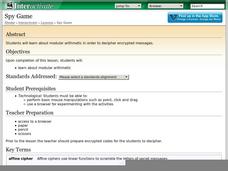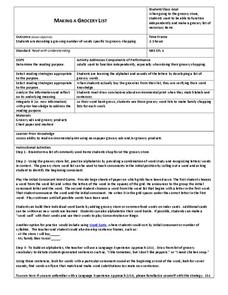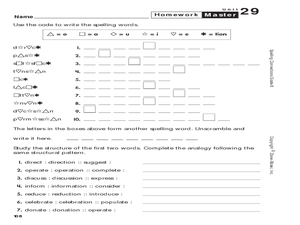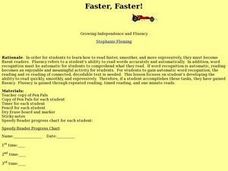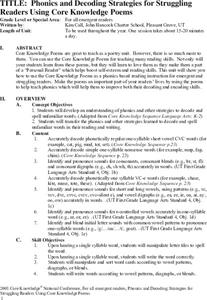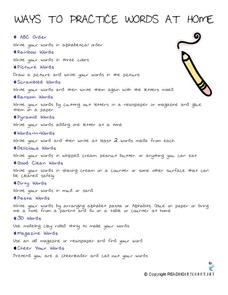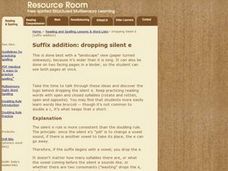Curated OER
SAT Preparation
The verbal and quantitative sections of the SAT can be a challenge for even the most erudite logophile. Prepare your test takers for the vocabulary they will encounter on standardized exams by providing them with a helpful list of roots,...
Shodor Education Foundation
Spy Game
Turn students into detectives as they decipher encrypted messages. Introduce your class to modular arithmetic and have a little fun encrypting and decoding secret messages. The activity does not hit many content standards, but would be...
Curated OER
Thanksgiving History
First graders decode Thanksgiving vocabulary while learning about the history of this holiday. In this Thanksgiving history lesson, 1st graders listen to a story, trace their hands to make turkey feathers and listen to a turkey poem. ...
Curated OER
Context Clues
Students develop vocabulary using pre -reading strategies. In this language arts lesson, students discuss the intended message from observing a picture. Additionally, students explore guessing the covered word within a text.
Curated OER
Making a Grocery List
Students make a list and decode words that are related to grocery shopping. In this grocery shopping lesson plan, students discuss what you do at the grocery store.
Curated OER
Symbol Code and Spelling Words
In this spelling worksheet, students use a code key with picture symbols to decode ten spelling words. Students decipher each word and print it on the lines.
Curated OER
Faster, Faster!
Pupils practice reading faster, smoother and more expressively by exercising the strategy of reading and rereading text to become more familiar with word recognition. They participate in reading a page or two of "Pen Pals" to personally...
Curated OER
Blending Bumper Cars
First graders practice blending words with the consonant-vowel-consonant pattern. Given a card with a decodable word part, 1st graders add an initial consonant sound and blend the sounds to read the new word. They practice reading a...
Curated OER
Parts of Speech Secret Decoder Puzzle
In this parts of speech secret decoder puzzle worksheet, 4th graders use the decoder key to solve fifteen words that are parts of speech.
Curated OER
B B BEE!!
Students recognize phonemes in spoken words and match letters to phonemes. They focus on the letter /b/ and the meaningful representation of the /b/. They read 'The Honeybee and the Robber' by Eric Carle and hold up their bees when...
Curated OER
Block Party
Sixth graders participate in a group reading of the children's book "Block Party". They work on the skill of prediction with the answering of guided questions asked by the teacher. Students also review decoding skills and practice sight...
Curated OER
Phonics and Decoding Strategies for Struggling Readers Using Core Knowledge Poem
Students complete multiple activities to help them hear sounds, syllables, and spell words with vowel patterns, digraphs, or blends. In this word sounds lesson, students use letter tiles, sort words cards, analyze poems, and play a bingo...
Curated OER
Decoding DNA
Third graders complete their KWL charts from the first lesson of the unit as a review for the summative. Then they decode a secret message using the four basic components of DNA, adenine, cytosine, guanine and thymine.
Curated OER
Decoding a Mystery Message from Space
Students examine a message sent from outer space and do their best to interpret its meaning. In this problem solving lesson, students investigate a code sent to them from "outer space." The students collaborate with their classmates to...
Shodor Education Foundation
Caesar Cipher
Caesar ciphers hide secret missives. A simple interactive lets users encode and decode hidden messages. The cipher method here is the Caesar shift.
Curated OER
Tomato Exploration
Create tomatoes in 15-20 minutes using this fun and interactive lesson plan! Learners listen to a book about tomatoes (recommendations listed), and focus on the vocabulary word tomato. They count the syllables and practice the plural....
American English
Welcome to the Color Vowel Chart
Focus English language learners' attention on word stress and phrase stress with a pronunciation chart that breaks the sounds into moving and non-moving vowel sounds. The chart tool uses colors and key words to indicate where to put the...
Reading Resource
Ways to Practice Words at Home
Looking for more ways to practice writing words? A list of 27 strategies will engage learners of any level. Kids can choose between writing their words in peanut butter, criss-crossing them with words that share common letters, and...
Houghton Mifflin Harcourt
Person to Person: Extra Support Lessons (Theme 4)
Authors use many strategies when writing stories. A series of extra support lessons breaks down those strategies, as well as key grammatical and phonics-based concepts to support struggling learners. The last of three lessons offers...
Curated OER
Guided Reading Organizer for Chain Reaction
The class uses Chain Reaction, a magazine, to build a better understanding of Latin and Greek roots found in scientific vocabulary. They use two attached worksheets to help them read a scientific article, using visual clues and their...
Curated OER
Break the Code: Anthropology Terms
Spice up your study of basic anthropology terms using this decoding learning exercise. Using a provided code, learners answer 10 fill-in-the-blank questions. Because the code is very simple, more advanced pupils may enjoy the challenge...
Curated OER
Aches and Pains
Being able to distinguish between short and long vowel /a/ sounds is an important skill for young readers. They are introduced to the vowel-consonant-e pattern that changes short vowel sounds into long vowel sounds. They practice reading...
Curated OER
Suffix Addition: Dropping Silent "e"
High schoolers engage in a lesson that is concerned with the concept of using the silent "e" in certain words. They practice using the rules while reading them in a review. The application of the rule is given in the lesson and can be...
Curated OER
The See-Saw: How to Blend
First graders listen as the word "cat" is sounded out spreading out all the sounds contained. They discover the meaning of blending using the word "cat" and then changing the consonants to make new words. They then figure out new words...
Other popular searches
- Decoding Skills Second Grade
- Phonetic Decoding Skills
- Teaching Decoding Skills
- Decoding Skills and Fluency
- Teach Decoding Skills
- Decoding Skills Worksheets
- Long Word Decoding Skills
- Encoding and Decoding Skills
- Literacy With Decoding Words



